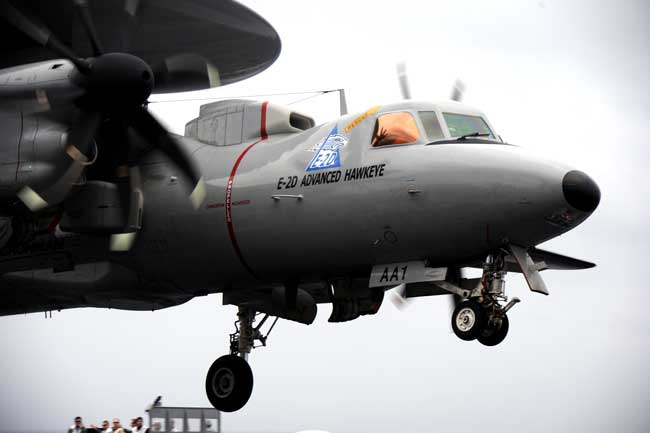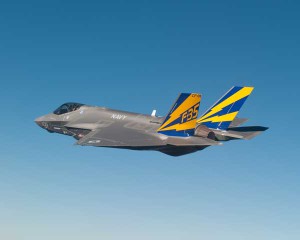Captain Kent “Torch” Whalen on the Evolution of the Air Arm
 Here Captain Whalen is seen in his role as Commander of the amphibious transport dock USS Juneau presenting a coin to Captain Yasuhiro of the Japanese Ground Self Defense Force (Credit: USN, http://bit.ly/iXASHx)
Here Captain Whalen is seen in his role as Commander of the amphibious transport dock USS Juneau presenting a coin to Captain Yasuhiro of the Japanese Ground Self Defense Force (Credit: USN, http://bit.ly/iXASHx)
05/17/2011 – During the late March visit to San Diego to the Naval Air Force, U.S. Pacific Fleet, Second Line of Defense sat down with Captain Whalen to discuss evolving approaches to maintenance as well also the challenge of managing the transition from older to new aircraft. The interview was wide-ranging and provided insightful perspectives from a pilot (initially trained on the A7 and then flew the Hornet for 17 years), and amphibious driver (the USS JUNEAU and USS DENVER) and the soon to be commander of the USS CARL VINSON. With such a breadth of experience, Whalen provided a sense of the challenges facing the evolution of the fleet.
SLD: Could you provide a perspective on the basic approach to air fleet management?
Captain Whalen: The readiness piece here is significant. We run the Defense Readiness Reporting System – Navy for the Naval Air Force.
SLD: For the Pacific?
Captain Whalen: No, both. East and West. I have a counterpart with a staff on the East Coast at Commander Naval Air Force Atlantic (CNAL). We are working under a single ACOS structure regarding policy.
The idea behind DRRS was that we could get all the services on the same reporting system, a joint system. The idea is they can talk with each other and be displayed with each other in a common approach and the Combatant Commanders and senior leadership could view all forces readiness in a similar format.
Right now, money is the biggest thing we’re paying attention to, I think, from a readiness standpoint.
SLD: How do you use the DRRS-N tool?
Captain Whalen: With the DRRS piece, we have a type model series class desk officer. So there’s one guy that’s the Helo guy, there’s a Hornet guy, there’s an E2 guy, etc.
SLD: They’re platform-specific.
Captain Whalen: Right. And they oversee that platform for the Airboss (Commander Naval Air Forces). They stay up to date on the community issues and future developments and assist the Type Wing Commodores and squadrons with any readiness questions they may have.
SLD: How do the age of the fleet and the challenges of managing the age of the fleet affect readiness and the challenges of transition?
Captain Whalen: Well, that’s a very good question. The Airboss will tell you that transitions are the most important thing we’re doing.
From old airframes to relatively new airframes every type model series has a transition in progress. The E2-C to the E2-D. Legacy Hornet to the Super Hornet. Quantum Leap, Hornet to JSF, helicopters are transitioning. The Prowler to Growler. So, we’re transitioning everything to something newer and more capable. And it’s obviously costly, but it is crucial to set Naval Aviation up for success down the road.
 An E-2D Hawkeye assigned to Air Test and Evaluation Squadron 20 completes a “touch-and-go” exercise aboard the aircraft carrier USS Harry S. Truman. The “D” model is aboard Harry S. Truman for carrier suitability testing before delivery to the fleet. Harry S. Truman is supporting fleet replacement squadron carrier qualifications. (Credit: USN Visual Service, 2/3/11)
An E-2D Hawkeye assigned to Air Test and Evaluation Squadron 20 completes a “touch-and-go” exercise aboard the aircraft carrier USS Harry S. Truman. The “D” model is aboard Harry S. Truman for carrier suitability testing before delivery to the fleet. Harry S. Truman is supporting fleet replacement squadron carrier qualifications. (Credit: USN Visual Service, 2/3/11)
SLD: With the stated requirement to keep 10 air wings available to the fleet, the challenge of managing the transitions must pose a significant challenge as well as the age of things like the much older Hornets.
Captain Whalen: If you look at the curves on the number of airframes available, we’ve basically got three lifecycle lines out there. We have the Legacy Hornet, the Super Hornet and then the JSF ramping up.
And we have to try to make sure there’s at least a minimum number of strike fighters to man ten air wings to go forward and run our contingency plans. We need to make sure that as the Legacy phases out we have enough Supers and JSF to meet the requirement, and then when the Supers start declining we have enough JSF to get the job done.
Do we take the Legacy out earlier and put more into Supers or do we try to accelerate JSF? That’s been where we spend some of our time trying to manage those numbers and those three curves.
SLD: It’s X plus Y plus Z equals your ten air wings.
Captain Whalen: Right. And there is another piece to the puzzle, namely TAI.
Our tac air integration (TAI) piece with the Marine Corps, where they contribute strike fighter squadrons to the air wings, is part of the evolving solution. We’re doing that now, and we’re investigating increasing the level of participation of the USMC on our large deck carriers.
Historically, and I flew with the marines and a USMC air wing when I was a department head, they’ll contribute a Hornet squadron to the air wing, and they’ll come and train with us, and they’ll deploy with us, and then go back home when the deployment’s over.
But we’re going to try to expand their role as we manage strike fighter shortfall issues. They can help us fill those potential holes in our force structure, if you will, down the road.
How many would they contribute and how many do we need? We don’t need so many Marine squadrons that we have to stand down Navy squadrons. That is not very effective use of the resources we currently have.
We know how many Navy squadrons we’ll have out there, and we can take some more Marine squadrons, potentially. Are they willing to contribute those? The equation is being worked.
SLD: What does the F-35C bring to the party? What does the F-35C bring to the carrier deck?
Captain Whalen: I think the ability to flow anywhere we need to go. The F-35C is a multi-threat platform able to respond to all the different mission areas that we’re prepared for. We’re a self-contained unit, we defend ourselves, we project power where needed. Just like you’re seeing in various corners of the globe.
It brings, obviously, newer technology, but more stealth, if you will. We have some of that, but not as much as we’d like to have.
It brings a lot more capability in terms of smart weapons and ease of operability, performance is improved from where we are currently. The fifth generation’s the whole next step.
And there is significantly more room for growth. The Legacy Hornet was built out. Its data buses couldn’t take any more improvements.
And so, Super Hornet came along, changed and improved in a number of ways. One of them was the architecture and electronic backbone that allowed us to add new radars and those kinds of things. But it is limited as well in terms of growth.
The JSF is the next step in that realm and brings 360-degree coverage with the latest and greatest technologies.

SLD: You are about to go to the USS Vinson and command this ship. How might we going forward gain more flexibility in mixing and matching our sea base capabilities, with aviation as a key connector?
Captain Whalen: I don’t want to give the impression that we’re tied necessarily to doing it the same way we’ve always done it. There’s some discussion here in the building about how do we deploy differently. For 40 years, we’ve loaded aboard and deployed for six months, all together and it all came back. Is there a better way to do that? Is there a smarter way to sail the carrier and join the air wing or pieces of it? What are the right pieces?
SLD: Mix and match more effectively?
Captain Whalen: Make it a little more customized, if you will.
SLD: You mentioned earlier you concern about the industrial base and our ability to maintain the fleet. Could you comment on this challenge?
Captain Whalen: My experience observing during two shipyard periods on the east coast where we were in Newport News in the dry dock, and then we were down around the corner in Portsmouth suggests our industrial base is at risk.
The loss of our industrial capacity, the skilled welders, the machinists, the shipyards in general, is going to be a real problem in the future. I think if you were to ask them, and I don’t know if you visit with them or not, but they (shipyard leadership) would tell you they have a very hard time finding and retaining talented and skilled workers.
So much so that we would come in on the carrier and they would pull workers from other projects, and other items to focus on the carrier or maybe focus on the submarine.
At our base in Lakehurst, New Jersey they’re building the EMALS (electromagnetic aircraft launch system) and the advanced arresting gear. But they also maintain the legacy catapult and arresting gear systems. One of the facilities they have at Lakehurst is a large in-house job shop, if you will.
It makes a significant number of the critical components for our current systems, filled with lathes and milling machines and welders. We maintain this facility to make these critical components for our arresting gear and cats that can’t be routinely manufactured by industry to the tight tolerances were looking for.
But we’re not, I don’t think, as a nation producing the skilled people to the rate we’re going to require to maintain the fleet down the road.

